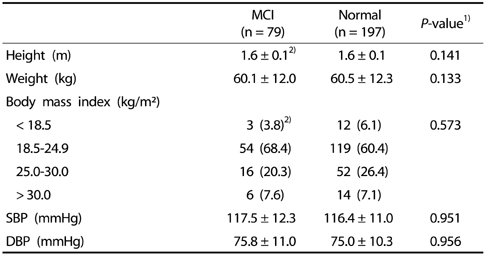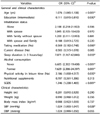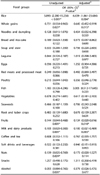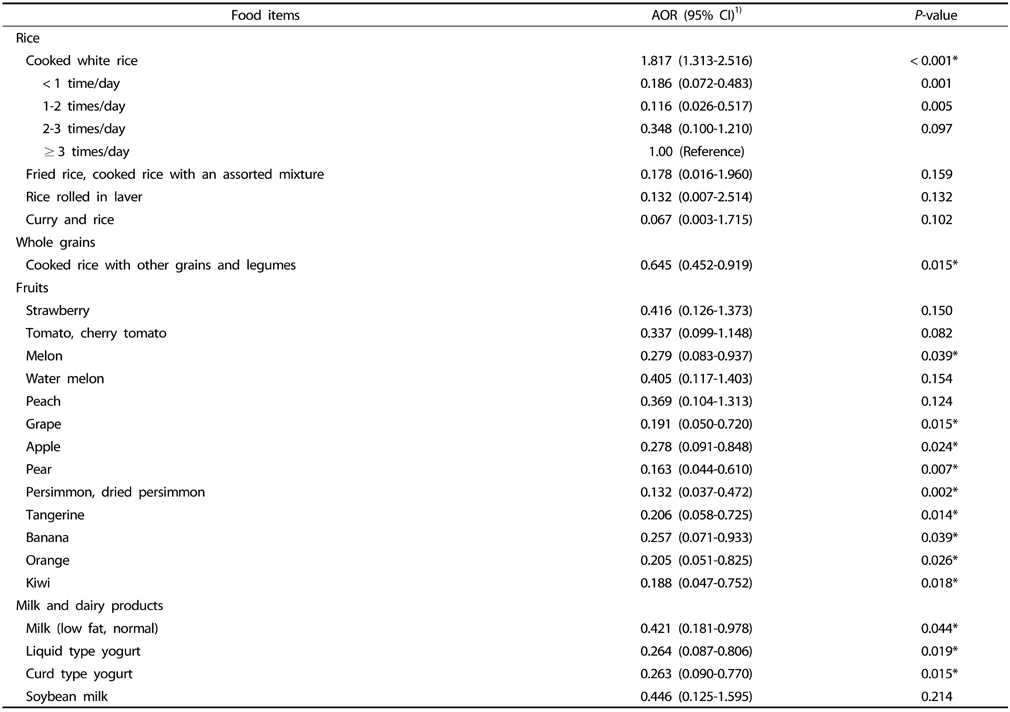1. Statistics Korea (KR). 2015 Statistics on the Aged. Daejeon: Statistics Korea;2015.
2. Roberts RO, Geda YE, Cerhan JR, Knopman DS, Cha RH, Christianson TJ, Pankratz VS, Ivnik RJ, Boeve BF, O'Connor HM, Petersen RC. Vegetables, unsaturated fats, moderate alcohol intake, and mild cognitive impairment. Dement Geriatr Cogn Disord. 2010; 29:413–423.

3. Geda YE, Ragossnig M, Roberts LA, Roberts RO, Pankratz VS, Christianson TJ, Mielke MM, Levine JA, Boeve BF, Sochor O, Tangalos EG, Knopman DS, Petersen RC. Caloric intake, aging, and mild cognitive impairment: a population-based study. J Alzheimers Dis. 2013; 34:501–507.

4. Koepsell TD, Monsell SE. Reversion from mild cognitive impairment to normal or near-normal cognition: risk factors and prognosis. Neurology. 2012; 79:1591–1598.

5. Cooper C, Sommerlad A, Lyketsos CG, Livingston G. Modifiable predictors of dementia in mild cognitive impairment: a systematic review and meta-analysis. Am J Psychiatry. 2015; 172:323–334.

6. Dean M, Grunert KG, Raats MM, Nielsen NA, Lumbers M;. The impact of personal resources and their goal relevance on satisfaction with food-related life among the elderly. Appetite. 2008; 50:308–315.

7. Gu Y, Nieves JW, Stern Y, Luchsinger JA, Scarmeas N. Food combination and Alzheimer disease risk: a protective diet. Arch Neurol. 2010; 67:699–706.
8. Scarmeas N, Stern Y, Mayeux R, Manly JJ, Schupf N, Luchsinger JA. Mediterranean diet and mild cognitive impairment. Arch Neurol. 2009; 66:216–225.

9. Scarmeas N, Stern Y, Mayeux R, Luchsinger JA. Mediterranean diet, Alzheimer disease, and vascular mediation. Arch Neurol. 2006; 63:1709–1717.

10. Ye X, Bhupathiraju SN, Tucker KL. Variety in fruit and vegetable intake and cognitive function in middle-aged and older Puerto Rican adults. Br J Nutr. 2013; 109:503–510.

11. Loef M, Walach H. Fruit, vegetables and prevention of cognitive decline or dementia: a systematic review of cohort studies. J Nutr Health Aging. 2012; 16:626–630.

12. Staubo SC, Aakre JA, Vemuri P, Syrjanen JA, Mielke MM, Geda YE, Kremers WK, Machulda MM, Knopman DS, Petersen RC, Jack CR Jr, Roberts RO. Mediterranean diet, micronutrients and macronutrients, and MRI measures of cortical thickness. Alzheimers Dement. 2017; 13:168–177.

13. Zhao X, Yuan L, Feng L, Xi Y, Yu H, Ma W, Zhang D, Xiao R. Association of dietary intake and lifestyle pattern with mild cognitive impairment in the elderly. J Nutr Health Aging. 2015; 19:164–168.

14. Dong L, Xiao R, Cai C, Xu Z, Wang S, Pan L, Yuan L. Diet, lifestyle and cognitive function in old Chinese adults. Arch Gerontol Geriatr. 2016; 63:36–42.

15. Morris MC, Tangney CC, Wang Y, Sacks FM, Bennett DA, Aggarwal NT. MIND diet associated with reduced incidence of Alzheimer's disease. Alzheimers Dement. 2015; 11:1007–1014.

16. Ozawa M, Shipley M, Kivimaki M, Singh-Manoux A, Brunner EJ. Dietary pattern, inflammation and cognitive decline: the Whitehall II prospective cohort study. Clin Nutr. 2017; 36:506–512.

17. Park JH, Kwon YC. Standardization of Korean Version of the Mini-Mental State Examination (MMSE-K) for Use in the Elderly. J Clin Psyhicatry. 2012; 73:1548–1554.
18. Huang CQ, Dong BR, Wu HM, Zhang YL, Wu JH, Lu ZC, Flaherty JH. Association of cognitive impairment with serum lipid/lipoprotein among Chinese nonagenarians and centenarians. Dement Geriatr Cogn Disord. 2009; 27:111–116.

19. Wang Z, Dong B, Zeng G, Li J, Wang W, Wang B, Yuan Q. Is there an association between mild cognitive impairment and dietary pattern in Chinese elderly? Results from a cross-sectional population study. BMC Public Health. 2010; 10:595–602.

20. Reisberg B, Ferris SH, de Leon MJ, Crook T. Global deterioration scale (GDS). Psychopharmacol Bull. 1988; 24:661–663.
21. Mitchell AJ, Bird V, Rizzo M, Meader N. Diagnostic validity and added value of the Geriatric Depression Scale for depression in primary care: a meta-analysis of GDS30 and GDS15. J Affect Disord. 2010; 125:10–17.

22. Greenberg SA. How to try this: the Geriatric Depression Scale: short form. Am J Nurs. 2007; 107:60–69.
23. Yun SH, Shim JS, Kweon S, Oh K. Development of a food frequency questionnaire for the Korea National Health and Nutrition Examination Survey: data from the fourth Korea National Health and Nutrition Examination Survey (KNHANES IV). Korean J Nutr. 2013; 46:186–196.

24. Khosravi M, Sotoudeh G, Majdzadeh R, Nejati S, Darabi S, Raisi F, Esmaillzadeh A, Sorayani M. Healthy and unhealthy dietary patterns are related to depression: a case-control study. Psychiatry Investig. 2015; 12:434–442.

25. Kim J, Jo I. Grains, vegetables, and fish dietary pattern is inversely associated with the risk of metabolic syndrome in South Korean adults. J Am Diet Assoc. 2011; 111:1141–1149.

26. Kim JH, Lee Y, Han G. Association of dietary factors with cognitive impairment in older women. J Prev Med Public Health. 2004; 37:174–181.
27. Teoh SL, Sudfangsai S, Lumbiganon P, Laopaiboon M, Lai NM, Chaiyakunapruk N. Chicken essence for cognitive function improvement: a systematic review and meta-analysis. Nutrients. 2016; 8:57–80.

28. Korea Health Industry Development Institute. National nutrition statistics 2015 [Internet]. Cheongju: Korea Health Industry Development Institute;2017. cited 2018 May 3. Available from:
https://www.khidi.or.kr/nutristat.
29. Chan SP, Yong PZ, Sun Y, Mahendran R, Wong JC, Qiu C, Ng TP, Kua EH, Feng L. Associations of long-term tea consumption with depressive and anxiety symptoms in community-living elderly: findings from the diet and healthy aging study. J Prev Alzheimers Dis. 2018; 5:21–25.

30. O'Keefe JH, Bhatti SK, Patil HR, DiNicolantonio JJ, Lucan SC, Lavie CJ. Effects of habitual coffee consumption on cardiometabolic disease, cardiovascular health, and all-cause mortality. J Am Coll Cardiol. 2013; 62:1043–1051.
31. Grosso G, Micek A, Castellano S, Pajak A, Galvano F. Coffee, tea, caffeine and risk of depression: a systematic review and dose-response meta-analysis of observational studies. Mol Nutr Food Res. 2016; 60:223–234.

32. Gillette-Guyonnet S, Secher M, Vellas B. Nutrition and neurodegeneration: epidemiological evidence and challenges for future research. Br J Clin Pharmacol. 2013; 75:738–755.

33. Cao L, Tan L, Wang HF, Jiang T, Zhu XC, Lu H, Tan MS, Yu JT. Dietary patterns and risk of dementia: a systematic review and meta-analysis of cohort studies. Mol Neurobiol. 2016; 53:6144–6154.

34. Vermeulen E, Stronks K, Visser M, Brouwer IA, Schene AH, Mocking RJ, Colpo M, Bandinelli S, Ferrucci L, Nicolaou M. The association between dietary patterns derived by reduced rank regression and depressive symptoms over time: the Invecchiare in Chianti (InCHIANTI) study. Br J Nutr. 2016; 115:2145–2153.

35. Lin PY, Huang SY, Su KP. A meta-analytic review of polyunsaturated fatty acid compositions in patients with depression. Biol Psychiatry. 2010; 68:140–147.

36. Kim HY, Lee JS, Youn JC, Chang MJ. Food and nutrient intake status of Korean elderly by degree of cognitive function. J Nutr Health. 2016; 49:313–322.

37. Chocano-Bedoya PO, O'Reilly EJ, Lucas M, Mirzaei F, Okereke OI, Fung TT, Hu FB, Ascherio A. Prospective study on long-term dietary patterns and incident depression in middle-aged and older women. Am J Clin Nutr. 2013; 98:813–820.

38. Opie RS, Itsiopoulos C, Parletta N, Sanchez-Villegas A, Akbaraly TN, Ruusunen A, Jacka FN. Dietary recommendations for the prevention of depression. Nutr Neurosci. 2017; 20:161–171.

39. Neergaard JS, Dragsbæk K, Christiansen C, Nielsen HB, Brix S, Karsdal MA, Henriksen K. Metabolic syndrome, insulin resistance, and cognitive dysfunction: does your metabolic profile affect your brain? Diabetes. 2017; 66:1957–1963.

40. Hu FB. Dietary pattern analysis: a new direction in nutritional epidemiology. Curr Opin Lipidol. 2002; 13:3–9.

41. Singh-Manoux A, Dugravot A, Brunner E, Kumari M, Shipley M, Elbaz A, Kivimaki M. Interleukin-6 and C-reactive protein as predictors of cognitive decline in late midlife. Neurology. 2014; 83:486–493.

43. Sadeghi O, Hassanzadeh-Keshteli A, Afshar H, Esmaillzadeh A, Adibi P. The association of whole and refined grains consumption with psychological disorders among Iranian adults. Eur J Nutr. 2017; DOI:
10.1007/s00394-017-1585-x.

44. Gu Y, Brickman AM, Stern Y, Habeck CG, Razlighi QR, Luchsinger JA, Manly JJ, Schupf N, Mayeux R, Scarmeas N. Mediterranean diet and brain structure in a multiethnic elderly cohort. Neurology. 2015; 85:1744–1751.

45. Luchsinger JA, Reitz C, Patel B, Tang MX, Manly JJ, Mayeux R. Relation of diabetes to mild cognitive impairment. Arch Neurol. 2007; 64:570–575.











 PDF
PDF ePub
ePub Citation
Citation Print
Print




 XML Download
XML Download